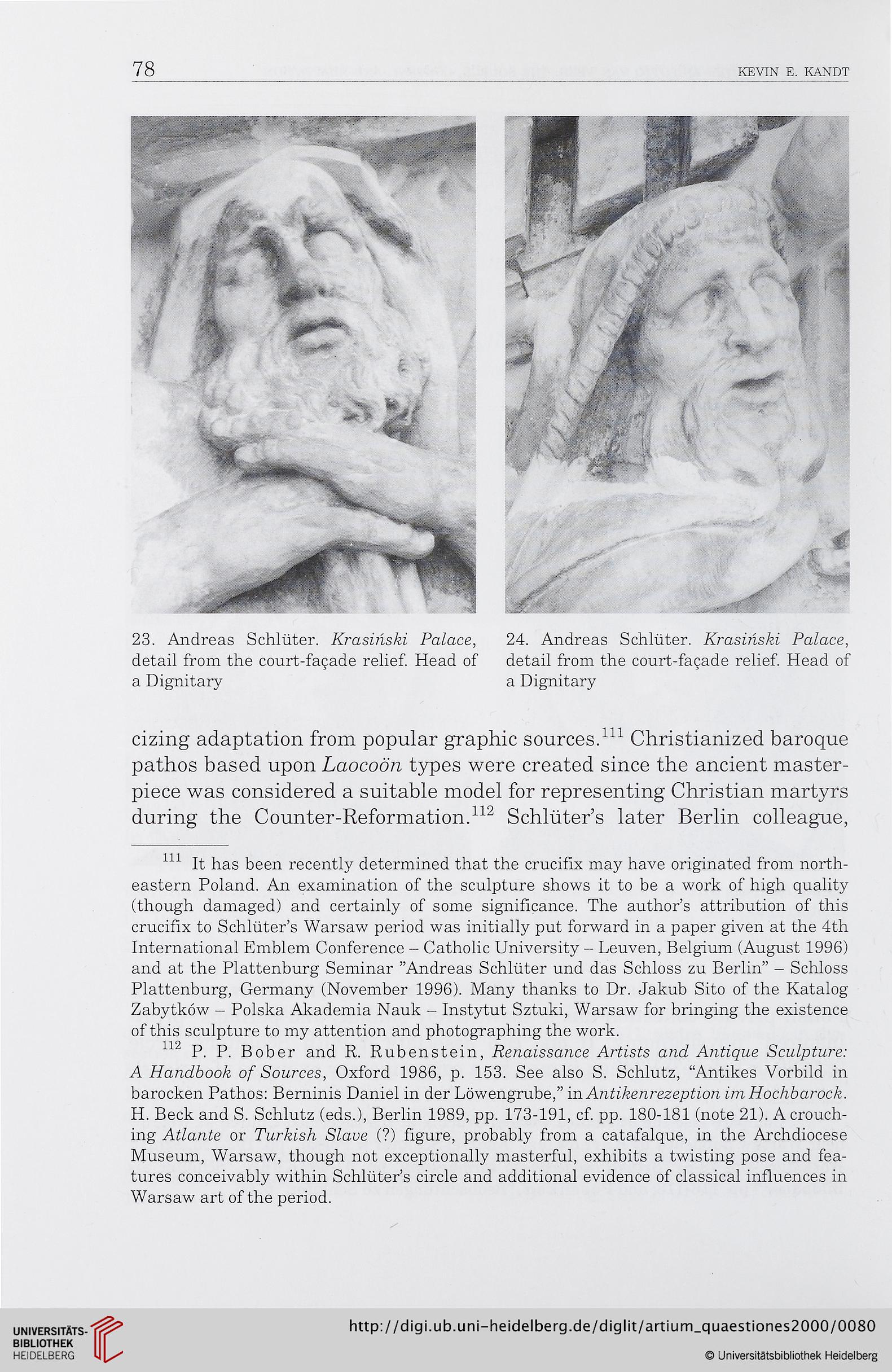78
KEVIN E. KANDT
23. Andréas Schlüter. Krasinski Palace, 24. Andréas Schlüter. Krasinski Palace,
detail from the court-façade relief. Head of detail from the court-façade relief. Head of
a Dignitary a Dignitary
cizing adaptation from popular graphie sources.111 Christianized baroque
pathos based upon Laocoôn types were created since the ancient master-
piece was considered a suitable model for representing Christian martyrs
during the Counter-Reformation.112 Schlüter’s later Berlin colleague,
111 It has been recently determined that the crucifix may hâve originated from north-
eastern Poland. An examination of the sculpture shows it to be a work of high quality
(though damaged) and certainly of some signifïcance. The author’s attribution of this
crucifix to Schlüter’s Warsaw period was initially put forward in a paper given at the 4th
International Emblem Conférence - Catholic University - Leuven, Belgium (August 1996)
and at the Plattenburg Seminar "Andréas Schlüter und das Schloss zu Berlin” - Schloss
Plattenburg, Germany (November 1996). Many thanks to Dr. Jakub Sito of the Katalog
Zabytkow - Polska Akademia Nauk - Instytut Sztuki, Warsaw for bringing the existence
of this sculpture to my attention and photographing the work.
112 P. P. Bober and R. Rubenstein, Renaissance Artists and Antique Sculpture:
A Handbook of Sources, Oxford 1986, p. 153. See also S. Schlutz, “Antikes Vorbild in
barocken Pathos: Beminis Daniel in der Lôwengrube,” in Antikenrezeption imHochbarock.
H. Beck and S. Schlutz (eds.), Berlin 1989, pp. 173-191, cf. pp. 180-181 (note 21). Acrouch-
ing Atlante or Turkish Slave (?) figure, probably from a catafalque, in the Archdiocese
Muséum, Warsaw, though not exceptionally masterful, exhibits a twisting pose and fea-
tures conceivably within Schlüter’s circle and additional evidence of classical influences in
Warsaw art of the period.
KEVIN E. KANDT
23. Andréas Schlüter. Krasinski Palace, 24. Andréas Schlüter. Krasinski Palace,
detail from the court-façade relief. Head of detail from the court-façade relief. Head of
a Dignitary a Dignitary
cizing adaptation from popular graphie sources.111 Christianized baroque
pathos based upon Laocoôn types were created since the ancient master-
piece was considered a suitable model for representing Christian martyrs
during the Counter-Reformation.112 Schlüter’s later Berlin colleague,
111 It has been recently determined that the crucifix may hâve originated from north-
eastern Poland. An examination of the sculpture shows it to be a work of high quality
(though damaged) and certainly of some signifïcance. The author’s attribution of this
crucifix to Schlüter’s Warsaw period was initially put forward in a paper given at the 4th
International Emblem Conférence - Catholic University - Leuven, Belgium (August 1996)
and at the Plattenburg Seminar "Andréas Schlüter und das Schloss zu Berlin” - Schloss
Plattenburg, Germany (November 1996). Many thanks to Dr. Jakub Sito of the Katalog
Zabytkow - Polska Akademia Nauk - Instytut Sztuki, Warsaw for bringing the existence
of this sculpture to my attention and photographing the work.
112 P. P. Bober and R. Rubenstein, Renaissance Artists and Antique Sculpture:
A Handbook of Sources, Oxford 1986, p. 153. See also S. Schlutz, “Antikes Vorbild in
barocken Pathos: Beminis Daniel in der Lôwengrube,” in Antikenrezeption imHochbarock.
H. Beck and S. Schlutz (eds.), Berlin 1989, pp. 173-191, cf. pp. 180-181 (note 21). Acrouch-
ing Atlante or Turkish Slave (?) figure, probably from a catafalque, in the Archdiocese
Muséum, Warsaw, though not exceptionally masterful, exhibits a twisting pose and fea-
tures conceivably within Schlüter’s circle and additional evidence of classical influences in
Warsaw art of the period.




